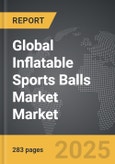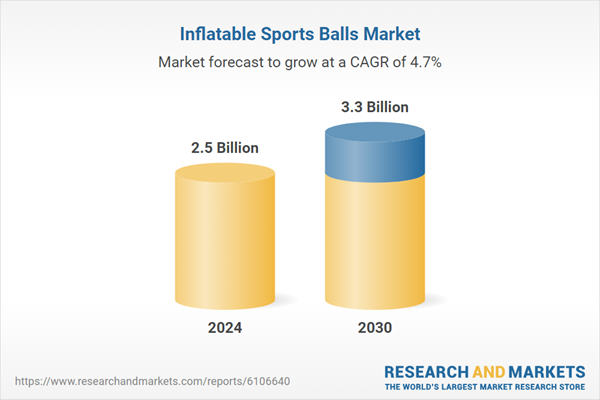Global Inflatable Sports Balls Market - Key Trends & Drivers Summarized
Why Are Inflatable Sports Balls Remaining Central to Global Sports Culture and Recreation?
Inflatable sports balls continue to be a fundamental component of both organized sports and casual recreational activities, maintaining relevance across a wide range of cultures, age groups, and skill levels. From professional leagues to schoolyards and community parks, inflatable balls are used in sports like football, basketball, volleyball, handball, and netball, each requiring specific performance standards tailored to the sport's unique dynamics. Their enduring popularity is fueled by a combination of accessibility, versatility, and tradition, as many global sports have deep-rooted histories centered around ball-based gameplay. In many regions, inflatable balls represent the first point of entry into physical activity for children, with educational institutions and sports development programs relying heavily on these products for early skills training and athletic engagement. Additionally, their affordability and portability make them ideal for use in resource-limited settings where sports infrastructure is minimal. Even in high-income countries, inflatable balls dominate school sports programs and recreational clubs due to their standardized dimensions, durable construction, and suitability for both indoor and outdoor use. Global sporting events such as the FIFA World Cup, the Olympics, and professional basketball tournaments further elevate the visibility of inflatable balls, sparking demand spikes among fans and aspiring athletes. As health awareness grows worldwide, more individuals are incorporating ball sports into their fitness routines for cardiovascular and coordination benefits, further boosting everyday use. This widespread utility across recreational and professional domains ensures that inflatable sports balls remain an irreplaceable part of the athletic landscape, transcending borders and socioeconomic status while reinforcing the global culture of play and competition.Can Innovation in Materials and Manufacturing Methods Redefine Performance Standards?
The evolution of inflatable sports balls is being propelled by advances in materials science, precision manufacturing, and digital design, all of which are redefining expectations for quality, durability, and performance. Modern inflatable balls are no longer simple rubber or leather constructions; they are now engineered with multi-layered synthetic composites, advanced bladder technologies, and textured surfaces designed to optimize aerodynamics, grip, and bounce. Thermo-bonded panels are replacing traditional stitched seams in high-performance soccer balls, creating more uniform spheres and reducing water absorption during wet conditions. Similarly, basketballs are now being developed with microfiber composite exteriors that provide a consistent feel and control even with prolonged indoor or outdoor use. High-quality latex or butyl bladders ensure better air retention and shape stability over time, reducing the need for frequent reinflation and enhancing user satisfaction. Manufacturers are also introducing eco-friendly materials such as recycled polyurethane and water-based adhesives in response to environmental concerns and consumer demand for sustainable products. Digital printing technology has improved the visual quality and brand customization options for team balls, training gear, and promotional items. Smart ball technology, integrating sensors and Bluetooth modules, is beginning to enter the market as well, allowing players and coaches to track ball movement, rotation, and speed in real time. These high-tech balls are used in elite training environments and are gradually being adopted in youth academies and amateur leagues. Such innovations are not only enhancing the playing experience but also contributing to athlete development and performance analysis. The fusion of advanced materials, digital integration, and production precision is revolutionizing inflatable sports balls, ensuring they keep pace with the increasingly demanding standards of modern sport.How Are Diverse Applications and User Segments Influencing Product Differentiation?
The inflatable sports balls market is highly segmented due to the diversity of end-users, from elite athletes to children learning their first game, and this variety is shaping the way products are developed, marketed, and sold. Professional-grade balls must meet strict regulatory standards set by international sports federations, such as FIFA, FIBA, and FIVB, which dictate everything from circumference and weight to rebound and pressure retention. These balls undergo rigorous testing for balance, seam strength, and environmental resilience, making them suitable for tournament-level play. In contrast, training balls are often made with reinforced but lower-cost materials to withstand repeated impacts and drills during practice sessions, especially in school or club settings. Youth and recreational segments demand balls that are softer, lighter, and safer for developing motor skills, leading to innovations in foam-layering and pressure-limiting technologies to prevent injury during early learning stages. Additionally, beach and water sports variations like beach volleyballs and water polo balls require specific textures, waterproof exteriors, and resistance to UV degradation. The promotional sector also commands a significant share of the market, with custom-branded balls being produced for giveaways, events, and corporate sponsorships. Retailers are responding with tiered product lines, offering basic recreational balls at entry-level price points while maintaining premium offerings for competitive play. Gender and age-specific designs are also gaining traction, with companies releasing balls tailored for women's sports leagues and youth programs, complete with adjusted sizing, lighter weights, and personalized aesthetics. These multifaceted applications have resulted in a broad spectrum of product categories, each optimized for different performance expectations, usage environments, and consumer preferences. The growing importance of personalization, safety, and regulatory compliance is ensuring that inflatable sports balls evolve to meet the nuanced needs of their expanding global audience.What Factors Are Fueling the Expansion of the Inflatable Sports Balls Market Worldwide?
The growth in the inflatable sports balls market is driven by several key factors rooted in increasing sports participation, rising global youth populations, institutional investments in physical education, and consumer demand for recreational equipment that balances performance with affordability. One of the most significant drivers is the global emphasis on youth development through sports, with schools, nonprofit organizations, and government programs investing heavily in ball-based physical education curricula and grassroots sports initiatives. The growing influence of international sports media and the popularity of global tournaments are also inspiring greater participation in ball sports, particularly among younger demographics who emulate professional athletes and teams. Urbanization and the proliferation of compact recreational spaces have further boosted the demand for portable and adaptable sports gear, and inflatable balls remain the go-to choice for pickup games and informal matches across basketball courts, soccer fields, and multi-use gyms. Economic growth in emerging markets is contributing to increased consumer spending on sporting goods, and brands are capitalizing on this trend by offering region-specific product lines and establishing local distribution networks. Online retail platforms and direct-to-consumer e-commerce strategies are expanding market reach and enabling smaller manufacturers to compete by offering niche or customized products. Furthermore, the seasonal nature of sports, coupled with back-to-school retail cycles and holiday gift demand, ensures a steady turnover of inventory and recurring sales opportunities. Institutional purchases from schools, sports academies, and training centers further anchor demand, creating bulk order cycles that sustain manufacturing throughput. Finally, heightened interest in active lifestyles and wellness across all age groups is supporting casual and fitness-based usage of inflatable sports balls, including for drills, agility training, and recreational play. Together, these trends are creating a strong and diverse foundation for continued market expansion, reinforcing the role of inflatable sports balls as both a staple of athletic development and a vehicle for global sports engagement.Report Scope
The report analyzes the Inflatable Sports Balls market, presented in terms of market value (US$). The analysis covers the key segments and geographic regions outlined below:- Segments: Ball Type (Inflatable Soccer Balls, Inflatable Footballs, Inflatable Volleyballs, Inflatable Basketballs, Other Inflatable Sports Balls); Distribution Channel (Online Distribution Channel, Offline Distribution Channel).
- Geographic Regions/Countries: World; United States; Canada; Japan; China; Europe (France; Germany; Italy; United Kingdom; Spain; Russia; and Rest of Europe); Asia-Pacific (Australia; India; South Korea; and Rest of Asia-Pacific); Latin America (Argentina; Brazil; Mexico; and Rest of Latin America); Middle East (Iran; Israel; Saudi Arabia; United Arab Emirates; and Rest of Middle East); and Africa.
Key Insights:
- Market Growth: Understand the significant growth trajectory of the Inflatable Soccer Balls segment, which is expected to reach US$1.2 Billion by 2030 with a CAGR of a 5.8%. The Inflatable Footballs segment is also set to grow at 5.2% CAGR over the analysis period.
- Regional Analysis: Gain insights into the U.S. market, valued at $687.7 Million in 2024, and China, forecasted to grow at an impressive 8.7% CAGR to reach $698.8 Million by 2030. Discover growth trends in other key regions, including Japan, Canada, Germany, and the Asia-Pacific.
Why You Should Buy This Report:
- Detailed Market Analysis: Access a thorough analysis of the Global Inflatable Sports Balls Market, covering all major geographic regions and market segments.
- Competitive Insights: Get an overview of the competitive landscape, including the market presence of major players across different geographies.
- Future Trends and Drivers: Understand the key trends and drivers shaping the future of the Global Inflatable Sports Balls Market.
- Actionable Insights: Benefit from actionable insights that can help you identify new revenue opportunities and make strategic business decisions.
Key Questions Answered:
- How is the Global Inflatable Sports Balls Market expected to evolve by 2030?
- What are the main drivers and restraints affecting the market?
- Which market segments will grow the most over the forecast period?
- How will market shares for different regions and segments change by 2030?
- Who are the leading players in the market, and what are their prospects?
Report Features:
- Comprehensive Market Data: Independent analysis of annual sales and market forecasts in US$ Million from 2024 to 2030.
- In-Depth Regional Analysis: Detailed insights into key markets, including the U.S., China, Japan, Canada, Europe, Asia-Pacific, Latin America, Middle East, and Africa.
- Company Profiles: Coverage of players such as Amneal Pharmaceuticals, ANI Pharmaceuticals, Biocodex SA, Boehringer Ingelheim, Catalyst Pharmaceuticals and more.
- Complimentary Updates: Receive free report updates for one year to keep you informed of the latest market developments.
Some of the 43 companies featured in this Inflatable Sports Balls market report include:
- Adidas
- Baden
- Canterbury
- Decathlon
- Diadora
- Gilbert
- Lotto
- Mikasa
- Molten
- Nike
- Peak
- PUMA
- Rawlings
- Select Sport
- Spalding
- STAR (Star Sporting Goods)
- Tachikara
- Umbro
- Voit
- Wilson
This edition integrates the latest global trade and economic shifts into comprehensive market analysis. Key updates include:
- Tariff and Trade Impact: Insights into global tariff negotiations across 180+ countries, with analysis of supply chain turbulence, sourcing disruptions, and geographic realignment. Special focus on 2025 as a pivotal year for trade tensions, including updated perspectives on the Trump-era tariffs.
- Adjusted Forecasts and Analytics: Revised global and regional market forecasts through 2030, incorporating tariff effects, economic uncertainty, and structural changes in globalization. Includes historical analysis from 2015 to 2023.
- Strategic Market Dynamics: Evaluation of revised market prospects, regional outlooks, and key economic indicators such as population and urbanization trends.
- Innovation & Technology Trends: Latest developments in product and process innovation, emerging technologies, and key industry drivers shaping the competitive landscape.
- Competitive Intelligence: Updated global market share estimates for 2025, competitive positioning of major players (Strong/Active/Niche/Trivial), and refined focus on leading global brands and core players.
- Expert Insight & Commentary: Strategic analysis from economists, trade experts, and domain specialists to contextualize market shifts and identify emerging opportunities.
Table of Contents
Companies Mentioned (Partial List)
A selection of companies mentioned in this report includes, but is not limited to:
- Adidas
- Baden
- Canterbury
- Decathlon
- Diadora
- Gilbert
- Lotto
- Mikasa
- Molten
- Nike
- Peak
- PUMA
- Rawlings
- Select Sport
- Spalding
- STAR (Star Sporting Goods)
- Tachikara
- Umbro
- Voit
- Wilson
Table Information
| Report Attribute | Details |
|---|---|
| No. of Pages | 283 |
| Published | December 2025 |
| Forecast Period | 2024 - 2030 |
| Estimated Market Value ( USD | $ 2.5 Billion |
| Forecasted Market Value ( USD | $ 3.3 Billion |
| Compound Annual Growth Rate | 4.7% |
| Regions Covered | Global |









